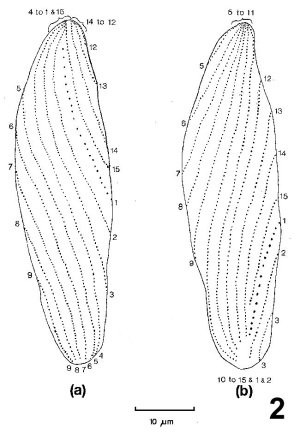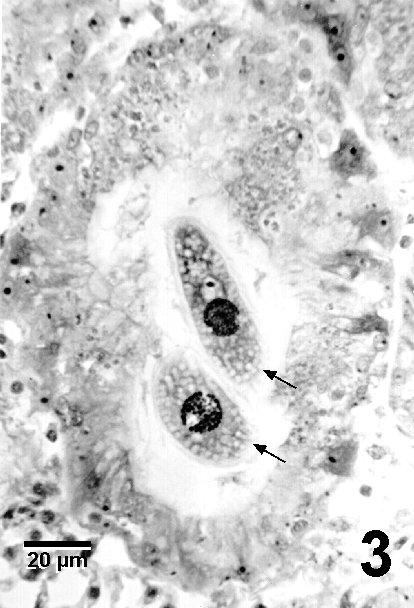Ancistrocoma-like Ciliates of Oysters
On this page
Category
Category 4 (Negligible Regulatory Significance in Canada)
Common, generally accepted names of the organism or disease agent
Ancistrocoma-like ciliates, Digestive tract Phyllopharyngea (thigmotrichid) ciliates of oysters, Digestive tube ciliates.
Scientific name or taxonomic affiliation
Stegotricha enterikos and other unidentified species of ciliate(s). Different species of ciliates may occur in different species of oysters.
Geographic distribution
Probably ubiquitous, frequently reported in oysters from both coasts of North America.
Host species
Crassostrea virginica, Crassostrea gigas, Ostrea edulis and other bivalves including clams.
Impact on the host
Although this ciliate lives in the lumen of the digestive gland tubules and may feed on the epithelial cells, no pathology has been directly associated with infection. Prevalence may reach 50% but the intensity of infection is usually low. However, Pauley et al. (1967) have described a host-defense response and suggest that these ciliates may have an effect under adverse growing conditions for oysters.
Diagnostic techniques
Squash Preparations
Observe (100X magnification) free swimming and attached ciliates in a tiny piece of digestive gland that is chopped and squashed in a drop of sea water.
Whole Mounts
The morphology of the ciliate can be examined by fixing smears of the digestive gland followed by staining with silver protein or iron haematoxylin.

Figure 1. Fixed whole mount preparation of two specimens of Stegotricha enterikos stained with silver protein (Protargol) showing the micronucleus (M) situated anterior to macronucleus (Ma), a cytopharyngeal structure (S) at the anterior end and the body surface covered by evenly spaced slightly oblique kineties (K) (ciliary rows).

Figure 2 (a and b). Drawing of both sides of one Stegotricha enterikos illustrating 15 evenly spaced kineties which are numbered to facilitate orientation. The unusual kinety with fewer and more widely spaced cilia is designated kinety 1, and all other kineties are consecutively numbered clockwise.

Figure 3. Histological section through two Stegotricha enterikos (arrows) inside the lumen of a digestive gland tubule within Crassostrea gigas. Black and white picture of a section that was stained with haematoxylin and eosin stain.
Histology
Spindle shaped ciliates with large, granular, polymorphic nuclei in the digestive gland. Although normally loose in the lumen of the digestive tubules, they may also be partially embedded between the tubule epithelial cells. Occasionally they may be observed in the digestive gland ducts or intestine.
Methods of control
No known methods of prevention or control.
References
Bower, S.M. and G.R. Meyer. 1993. Stegotricha enterikos gen. n., sp. n. (Class Phyllopharyngea, Order Rhynchodida), a parasitic ciliate in the digestive gland of Pacific oysters (Crassostrea gigas) and its distribution in British Columbia. Canadian Journal of Zoology 71: 2005-2017.
Cheng, T.C. 1967. Marine molluscs as hosts for symbioses with a review of known parasites of commercially important species. Advances in Marine Biology 5: 1-424.
Couch, J.A. 1985. Prospective study of infectious and noninfectious disease in oysters and fishes in three Gulf of Mexico estuaries. Diseases of Aquatic Organisms 1: 59-82.
Fenchel, T. 1965. Ciliates from Scandinavian Molluscs. Ophelia 2(1): 71-174.
Otto, S. V., Harshbarger, J. C. and Chang, S. C. 1979. Status of selected unicellular eucaryote pathogens, and prevalence and histopathology of inclusions containing obligate procaryote parasites, in commercial bivalve mollusks from Maryland estuaries. Haliotis 8 (1977): 285-295.
Pauley, G.B., Chew, K.K. and Sparks, A.K. 1967. Experimental infection of oysters (Crassostrea gigas) with thigmotrichid ciliates. Journal of Invertebrate Pathology 9: 230-234.
Sprague, V. 1970. Some protozoan parasites and hyperparasites in marine bivalve molluscs. American Fisheries Society Special Publication 5: 511-526.
van Banning, P. 1979. Protistan parasites observed in the European Flat Oyster (Ostrea edulis) and the cockle (Cerastoderma edule) from some coastal areas of the Netherlands. Haliotis 8 (1977): 33-37.
Citation Information
Bower, S.M., Meyer, G.R. (1998): Synopsis of Infectious Diseases and Parasites of Commercially Exploited Shellfish: Ancistrocoma-like Ciliates of Oysters.
Date last revised: September 1998
Comments to Susan Bower
- Date modified: